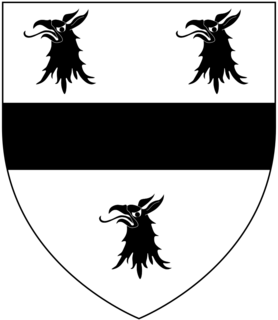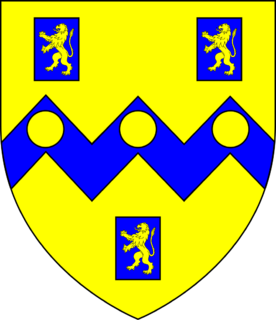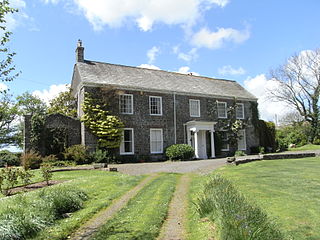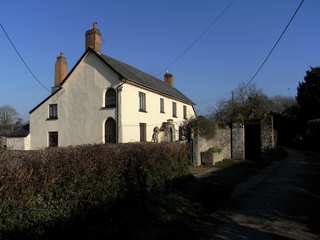
Kenedon is an historic manor situated in the parish of Sherford in Devon.

Kenedon is an historic manor situated in the parish of Sherford in Devon.
It is listed in the Domesday Book of 1086 as Chenigedone, the 55th of the 58 Devonshire holdings of Ralph de Pomeroy, [2] feudal baron of Berry Pomeroy, one of the Devon Domesday Book tenants-in-chief of King William the Conqueror. It was subsequently held by the Praulle (alias Prall) family, under the overlordship of the honour of Berry Pomeroy. [3] Roger Prall held it in 1242 [4] (during the reign of King Henry III (1216-1272)), and his descendants, two of whom were named William, held it for a further three generations. [5] It then became the seat of John Hals (fl.1423) (son of John Hals of Lavant in Cornwall [6] ), a Justice of the Common Pleas and in 1423 a Justice of the King's Bench. [7] [8] His second son was John Hales (c. 1400-1490), [9] Bishop of Coventry and Lichfield (1459-1490). The Bishop's great-uncle was Richard Hals [10] (d.1418), a Canon of Exeter Cathedral in Devon, and Treasurer of Exeter Cathedral in 1400, who in 1414 was sent as Ambassador to Brittany. [11] The Hals family held it for many generations, although they moved their seat to Efford in the parish of Egg Buckland, which manor they had inherited by the marriage of Richard III Hals (great-grandson of John Hals the judge) to Joan Whitley, 2nd daughter and co-heiress of Richard Whitley of Efford. Finally, following the death of Matthew Halse (1657/8-1684) of Efford without male progeny, the Hals estates descended to his sisters:
The mansion house was originally quadrangular in form, and is today represented by a small 16th c. farmhouse known as Keynedon, about 1 mile south of the village of Sherford. [14] The early 15th century gate-tower of the house was demolished in about 1850. [15]

Sir Jonathan Trelawny, 2nd Baronet, of Trelawny in the parish of Pelynt in Cornwall, England, was a Member of Parliament.

Brigadier-General Henry Trelawny was a British Army officer of Cornish descent, a Member of Parliament and Vice-Admiral of Cornwall.

John Hales was Bishop of Coventry and Lichfield (1459-1490). He was one of the Worthies of Devon of the biographer John Prince (d.1723).
Efford is an historic manor formerly in the parish of Eggbuckland, Devon, England. Today it has been absorbed by large, mostly post-World War II, eastern suburb of the city of Plymouth. It stands on high ground above the Laira estuary of the River Plym and provides views over long distances: to the north across Dartmoor, to the east and south-east across the South Hams. It consists predominantly of local authority and housing association properties. Before this land was built upon it was known as 'The Wilds of Efford', and was largely unspoilt countryside and marsh land. That a deer park may have been attached to the manor is suggested by the survival of the street name "Deer Park Drive".
Sir Richard Reynell, of Pitney in the county of Somerset, Sheriff of Devon in 1191-4, was a knight who lived during the successive reigns of Kings Henry II (1154-1189), Richard I (1189-1199) and John (1199-1216).

Roborough is a village and civil parish 5.5 mi (8.9 km) from Great Torrington, in Devon, England. Situated topographically on the plateau between the Torridge and Taw Rivers, the parish covers 1,258 ha and contains a population of some 258 parishioners. It is surrounded by a pastoral landscape of rectangular fields, high hedges and scattered farmsteads.

John Rolle (1522–1570) of Stevenstone, in the parish of St Giles in the Wood, near Great Torrington, Devon, was the eldest son and heir of George Rolle, MP, founder of the great Rolle family of Stevenstone, by his second wife Eleanor Dacres. Three monuments survive in memory of his immediate family in the churches of St Giles in the Wood and Chittlehampton.

The manor of Wadham in the parish of Knowstone in north Devon and the nearby manors of Chenudestane and Chenuestan are listed in the Domesday Book of 1086:
The manor of Bideford in North Devon was held by the Grenville family between the 12th and 18th centuries. The full descent is as follows:

Peamore is a historic country estate in the parish of Exminster, Devon, which is near the city of Exeter. In 1810 Peamore House was described as "one of the most pleasant seats in the neighbourhood of Exeter". The house was remodelled in the early 19th century and is now a grade II listed building.

Thuborough in the parish of Sutcombe, Devon, England, is an historic estate, formerly a seat of a branch of the Prideaux family, also seated at Orcharton, Modbury; Adeston, Holbeton; Soldon, Holsworthy; Netherton, Farway; Ashburton; Nutwell, Woodbury; Ford Abbey, Thorncombe, all in Devon and at Prideaux Place, Padstow and Prideaux Castle, Luxulyan, in Cornwall. The present mansion house, comprising "Thuborough House" and "Thuborough Barton", the north-east block, is a grade II listed building.
Floyer Hayes was an historic manor in the parish of St Thomas on the southern side of the City of Exeter in Devon, England, from which city it is separated by the River Exe. It took its name from the ancient family of Floyer which held it until the early 17th century, when it was sold to the Gould family. In the 19th century the estate was divided up and the manor house demolished. The parish church of St Thomas, situated a short distance to the west of the house, was burned down in 1645 during the Civil War, and was rebuilt before 1657. Thus no monuments survive there of early lords of the manor, namely the Floyer family.
Budockshed is a historic estate in the parish of St Budeaux, near Plymouth in Devon, England.

Milton Abbot is a village, parish, and former manor in Devon, 6 miles (9.7 km) north-west of Tavistock, Devon, and 6 miles (9.7 km) south-east of Launceston, Cornwall.
Sandridge is an historic estate in the parish of Stoke Gabriel in Devon, situated on high ground at the head of the River Dart estuary. The estate was originally encompassed on three sides by the river, which meanders along its border, leaving it on the east side. The present grade II* listed Italianate style Regency mansion house known as Sandridge House was built in 1805 by Lady Ashburton, to the design of John Nash.

Moor Hays is a historic estate in the parish of Cullompton in Devon, England. It is stated incorrectly to be in the nearby parish of Burlescombe in Tristram Risdon's Survey of Devon. The estate is not to be confused with Moor Hayes in the parish of Washfield, about 3 miles north-west of Tiverton, another ancient farmstead, which since 2005 has been the site of a large housing estate named "Moorhayes".

Sherford is a village and former civil parish and manor, now in the parish of Frogmore and Sherford, in Devon, situated about 2 1/2 miles east of the town of Kingsbridge. It should not be confused with the new town Sherford to be built on the outskirts of Plymouth, about 18 miles to the north-west. The parish church is dedicated to Saint Martin of Tours. In 1961 the parish had a population of 258. The parish was abolished in 1986 and merged with parts of South Pool and Charleton to form "Frogmore and Sherford".

South Milton is a village and civil parish in Devon, England, situated on the south coast about 2 miles south-west of Kingsbridge. The civil parish includes the hamlets of Sutton, south of the village, and Upton, north of the village.

Hareston is an historic estate in the parish of Brixton, about three miles from Plymouth in Devon. The mansion house built during the reign of King Henry VII (1485-1509) burned down partially in an accidental fire at the beginning of the 18th century, and in 1822 the surviving part, the Hall and Chapel, was being used as a farmhouse. It was described by Candida Lycett Green in her 1991 book The Perfect English Country House as: "The most forgotten Manor House Farm In England, untouched for hundreds of years, sits safely, impossible to find, down miles of private sunken lanes which in the spring brim with Campion, Bluebells, Purple Orchids, Primroses, Violets, Speedwell and Stitchwort. Wooded hills rise behind this, the quintessence of an ancient English Manor House".

Weycroft is an historic manor in the parish of Axminster in Devon, England. The surviving manor house known as "Weycroft Hall" is a Grade I listed building which includes elements from the 15th, 16th and 17th centuries, with a great hall of circa 1400, and was restored in the 19th century.